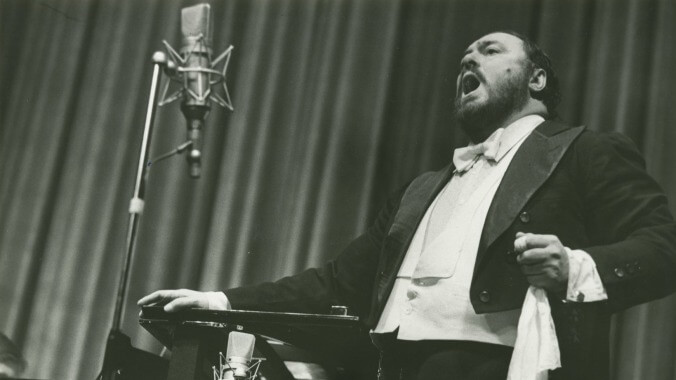Ron Howard’s opera documentary Pavarotti can’t find the man behind the voice


Luciano Pavarotti the superstar, the popularizer, the sell-out. By the 1990s, the bajillion-record-selling Italian tenor had all but abandoned the opera stage to play sports arenas and benefit concerts. He recorded cheesy crossover singles with the likes of Céline Dion. Nearly everything about him courted ridicule: the bad dye job, the silk hankies, the fake eyebrows, the cancellations, the overwhelming obsession with celebrity. Not to mention that the guy couldn’t act, couldn’t read music, and had neither the versatility nor the repertoire of his friend Plácido Domingo, who would emerge from the lucrative Three Tenors enterprise with his reputation unscathed. But no one could dispute the voice. Although the consensus was that Pavarotti’s control of his freak-of-nature upper register peaked in his 30s (which is to say, a couple of decades before the Three Tenors era), his voice remained remarkable: bright, clear, unmistakable even to the untrained ear.
Ron Howard’s documentary Pavarotti is content to bask in his glow; despite the broad array of home movies, family photos, interviews, TV outtakes, and concert recordings at its disposal, it never feels intimate with Pavarotti the person. If anyone who knew him had anything but nice things to say about the guy, they don’t say it here. (One wouldn’t know, for instance, that Pavarotti’s longtime manager, the late Herbert Breslin, who appears extensively in vintage interviews and video clips, wrote a bitter tell-all about the singer after they split—or that they split at all.) Instead, what it offers is an easily digestible chronology of Pavarotti the phenomenon, breezing in mere minutes from his beginnings as the son of an amateur tenor in Modena—the humble home of Ferrari, Maserati, and balsamic vinegar—to his first glimpses of international recognition in the 1960s and his successful early tours with the soprano Joan Sutherland. Howard, ever the dependable populist, knows that his target audience (broadly: PBS tote-bag people of a certain age) don’t want to hear about music lessons. They want to hear Pavarotti sing.
To be fair, Howard does try to move the discussion of Pavarotti’s talent beyond broad superlatives like “genius” and “maestro,” employing interviews with opera singers (including his Three Tenors colleagues Plácido Domingo and José Carreras) to explain why, for instance, the role of Tonio in Donizetti’s La Fille Du Régiment, which requires a singer to hit at least eight high Cs in a single aria, turned out to be a star-making one for the tenor. But one can’t help but detect some self-identification on Howard’s part, especially in the way his camera seems to hang on Domingo’s summation of the opera singer’s craft: “The public don’t know what you’re doing, but they feel it.” Not unlike the Hollywood veteran’s earlier (and better) music documentary The Beatles: Eight Days A Week—The Touring Years, Pavarotti focuses on crowd-pleasing—the tenor as an unpretentious, energetic live performer, mobbed by gushing fans. The difference is that the Fab Four would go on to prove just how adventurous and ambitious popular art could be, whereas Pavarotti remained devoted to classic Italian opera. He had zero interest in any kind of modern music that didn’t involve him sharing a stage with the Spice Girls or Sting. First, he sang Verdi and Puccini arias in opera houses; later, he sang them on TV. But that shouldn’t discount the fact that he sang them like no one else.
Still, Howard and editor Paul Crowder have some fun unearthing time capsules of a bygone era of global celebrity: shots of music stores filled with Pavarotti standees and banners; talk-show appearances with Phil Donahue and Johnny Carson; clips of the tenor shilling for everything from American Express to Lavazza Coffee (in an ad campaign directed by The Battle Of Algiers’ Gillo Pontecorvo, no less); footage from some kind of branded tennis competition called “the Pavarotti Pro-Am, Sponsored By Atari.” Produced with the help of the tenor’s estate, Pavarotti is almost awkwardly diplomatic in the way it handles its subject’s extramarital affairs, preferring to portray Pavarotti the way he wanted to be portrayed—as an ordinary family man with a tremendous gift who loved spaghetti and charity, repeatedly dismissing his diva reputation as mere “criticism.” Whatever that means.
One can’t help but think that it probably wasn’t that simple. There are hints of dissatisfaction and estranged relationships sprinkled throughout Pavarotti, but any attempt to portray a less-than-ebullient side of the opera star seem to push up against the limits of both Pavarotti’s and Howard’s art. (See: a sequence that intercuts reminisces of Pavarotti’s professional burnout toward the end of the 1980s with footage of the tenor performing the role of the murderous clown in Pagliacci.) Pavarotti may have succeeded in bringing the rarefied highs of opera to the masses, but as a personality, he remains out of reach.